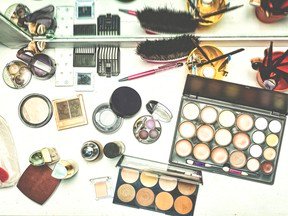A Complete Guide to Acrylic Nails

Introduction
Acrylic nails have become a popular choice in the world of nail enhancements, offering a durable and versatile solution for achieving beautiful manicures. These artificial nails are created by combining a liquid monomer with a powder polymer to form a paste that can be shaped and bonded to the natural nail.
In this complete guide to acrylic nails, we will walk you through everything you need to know about this nail enhancement technique. From the application process to proper maintenance and removal techniques, we’ve got you covered. Whether you’re a nail enthusiast looking to try something new or a professional nail technician seeking to expand your skills, this guide will provide valuable insights and practical tips.
Understanding Acrylic Nails: Benefits, Differences, and Shaping Techniques
Acrylic nails have gained immense popularity for their ability to strengthen, lengthen, and thicken natural nails. Being aware of the application process and the materials involved is crucial in achieving salon-like results even from the comfort of your home.
How Acrylic Nails Are Applied
The process of applying acrylic nails demands careful execution. While it’s advisable to seek professional assistance, practicing at home can yield great outcomes. Here’s a step-by-step guide:
- Preparing Your Nails: Begin by removing any nail polish and using a file to shape your natural nails. Gently push back your cuticles with a cuticle pusher.
- Using Nail Primer: Apply a thin coat of nail primer on your natural nails to ensure proper adhesion of the acrylic. Allow the primer to dry completely.
- Mixing the Acrylic: Follow the manufacturer’s instructions to mix liquid monomer and powder polymer in appropriate proportions. The liquid monomer activates the powder polymer, transforming it into a malleable paste for shaping.
- Placing Nail Forms: Position a nail form under the edge of your natural nail, ensuring a snug fit. This form will serve as a guide for creating the desired shape and length of your acrylic nails.
- Applying the Acrylic: Dip an acrylic brush into the liquid monomer, removing any excess liquid. Next, pick up a small amount of acrylic paste with the brush and place it near your cuticles. Stroke the brush gently down towards the tip of your nail, evenly spreading the acrylic. Repeat this process for all your nails.
- Shaping Your Nails: Employ the brush dipped in liquid monomer to meticulously shape and smooth out the acrylic on your nails. Eliminate any bumps or unevenness and craft the desired shape, be it square, round, or almond.
- Letting It Dry: Allow a few minutes for the acrylic to dry and harden. Once fully cured, you can file and shape your acrylic nails to perfection. Buffing and polishing will further enhance their appearance.
The Main Materials Used: Liquid Monomer and Powder Polymer
Creating acrylic nails entails the use of two primary materials: liquid monomer and powder polymer. These substances collaborate to form a robust acrylic paste that adheres well to your natural nail.
- Liquid Monomer: This chemical compound plays a pivotal role in the creation of acrylic nails. It triggers the activation of the powder polymer, transforming it into a paste suitable for application on your natural nail. Liquid monomer also enhances adhesion, ensuring longevity.
- Powder Polymer: Derived from polymethyl methacrylate (PMMA), this substance imparts strength and thickness to acrylic nails. When combined with liquid monomer, it assumes a paste-like consistency that can be molded onto your nails. Available in various colors, powder polymer offers a wide range of shade options for your acrylic nails.
Understanding these materials and their application techniques is instrumental in achieving stunning and
Pros and Cons of Opting for Acrylic Nails
When thinking about getting acrylic nails, it’s important to know the good and bad points so you can decide if they’re right for you. Here are the advantages and disadvantages of choosing acrylic nails:
Advantages of Acrylic Nails:
- Durability: Acrylic nails are really strong, which makes them great if you’re always on the go. You can do your daily activities without worrying about them getting damaged easily or breaking. They’ll stay looking good for a long time.
- Versatility: With acrylic nails, you have lots of options for how you want your nails to look. You can choose different shapes, lengths, and designs to match your style. Whether you like a simple French manicure or bold nail art, acrylics can be customized just for you.
- Low Maintenance: Unlike natural nails that need regular care, acrylic nails are easy to take care of. Once they’re put on, they don’t need much attention. You won’t have to constantly fix them up, so you can enjoy having beautiful nails without any hassle.
Disadvantages of Acrylic Nails:
- Potential Nail Damage: Using acrylic nails for a long time can make your natural nails weaker. Putting them on and taking them off can make your nails thinner and more likely to break. You’ll need to be extra careful and give your natural nails some extra care to keep them healthy.
- Risk of Fungal Infections: If acrylic nails aren’t applied correctly or there’s moisture trapped under them, it can create a place where fungus can grow. To lower the chances of getting an infection, it’s really important to keep your nails clean and take good care of them.
By thinking about these things carefully, you can decide if acrylic nails are the right choice for you based on your lifestyle and how you like to take care of your nails.
How Long Do Acrylic Nails Last?
Acrylic nails typically last for about six to eight weeks before requiring a fill or maintenance session. However, the actual longevity of acrylic nails can be influenced by several factors, including:
1. Nail Growth Rate
The rate at which your natural nails grow will impact how long your acrylic nails maintain their appearance. Faster nail growth may result in a more noticeable gap between the cuticle and the acrylic, prompting the need for more frequent fills.
2. Daily Activities
Your daily routine and activities can also affect the lifespan of acrylic nails. Engaging in tasks that subject your nails to excessive wear and tear, such as heavy typing, crafting, or sports, may lead to quicker deterioration of the acrylic material.
3. Maintenance
Proper maintenance of acrylic nails, including regular fills and addressing any issues like lifting or cracks promptly, can contribute to prolonging their lifespan.
It’s essential to monitor the condition of your acrylic nails regularly and schedule fill appointments based on the growth and overall wear. By staying attentive to these factors, you can optimize the duration of time between fill sessions while keeping your manicure looking fresh and well-maintained.
Taking It Off: The Right Way to Remove Acrylic Nails
Removing acrylic nails can be a delicate process that requires care and precision to avoid causing damage to the natural nails underneath. While it may be tempting to try DIY removal methods at home, it is highly recommended to seek professional help for the best and safest results. Here are some key reasons why professional removal is the preferred option:
- Minimize Damage: Professional nail technicians have the expertise and proper tools to remove acrylic nails without causing any harm to your natural nails. They know how to safely dissolve the adhesive and gently file away the remaining product, ensuring that your natural nails remain intact.
- Avoid Infection: Removing acrylic nails improperly can create small openings or tears in the nail bed, which can increase the risk of bacterial or fungal infections. Professionals follow strict hygiene practices during removal, reducing the chances of any such infections.
- Save Time and Effort: Acrylic nail removal requires patience and skill. By entrusting this task to a professional, you can save yourself time and effort, allowing you to relax while they take care of the process.
If salon access is limited or you prefer to remove your acrylic nails at home, here is a step-by-step guide on how to safely remove them:
Gather Your Supplies
- Acetone: Look for pure acetone or an acetone-based nail polish remover.
- Aluminum Foil: Cut square pieces large enough to wrap around each finger.
- Cotton Balls or Pads: Soak them in acetone and place them on top of each nail.
- Nail File or Buffer: Use a gentle file or buffer to remove any remaining product after soaking.
Prepping Your Nails
- Use a nail clipper to trim down the length of your acrylic nails as much as possible without cutting into your natural nails.
- Gently file the surface of each nail to remove the shiny topcoat and expose the acrylic product.
Soak Your Nails
- Soak a cotton ball or pad in acetone and place it on top of your nail.
- Wrap the aluminum foil around your finger, securing the cotton ball in place.
- Repeat this process for all fingers and let them soak for about 15-20 minutes.
Removal Process
- After the soaking period, gently press down on each nail and pull off the foil.
- Use a gentle twisting motion to remove any loosened acrylic product from your natural nails. Be patient and avoid forcing it off, as this can cause damage.
- If there are any stubborn areas that won’t come off easily, you can use a gentle file or buffer to carefully remove them.
Moisturize and Nourish
- After removing all the acrylic product, wash your hands thoroughly with soap and water to remove any remaining acetone residue.
- Apply a generous amount of cuticle oil or a nourishing hand cream to hydrate and restore moisture to your nails and surrounding skin.
Remember, DIY removal is not without risks, so it’s important to exercise caution. If you encounter any difficulties or have concerns about removing your acrylic nails at home, it’s best to consult a professional for assistance. Your natural nails will thank you for it!
Caring for Your Natural Nails Post-Acrylics
After removing acrylic nails, it’s important to give your natural nails some extra attention and care. Here are some essential tips for nourishing and restoring the health of your natural nails:
1. Moisturize Regularly
One of the key aspects of caring for your natural nails post-acrylics is moisturizing. Acrylics can leave your nails dry and brittle, so applying a good quality hand cream or cuticle oil regularly will help restore moisture and improve nail flexibility.
2. Use Nail Strengtheners
To promote nail growth and strengthen your natural nails, consider using a nail strengthener or hardener. These products contain ingredients like keratin and calcium that can help fortify your nails and prevent breakage.
3. Trim and Shape
After removing acrylics, take the time to trim your nails to a desired length and shape them using a file. Be gentle while filing to avoid any further damage to the nail bed.
4. Avoid Harsh Chemicals
Protect your natural nails by avoiding exposure to harsh chemicals found in cleaning products or nail polish removers. Consider wearing gloves when doing household chores to minimize contact with these substances.
5. Give Your Nails a Break
It’s essential to let your natural nails breathe and recover after long periods of wearing acrylics. Take breaks between manicures to allow your nails to rejuvenate and grow naturally. Experts recommend giving your nails a break from acrylics every three to six months.
Remember, proper maintenance and care are crucial for the health of your natural nails. Here are some precautionary measures you can take:
- Wear Gloves: When engaging in activities that involve water or harsh chemicals, such as washing dishes or cleaning, protect your natural nails by wearing gloves. This will help prevent them from becoming weak or damaged.
- Avoid Excessive Filing: While it’s important to shape your nails, be mindful not to over-file them. Excessive filing can thin out the nail bed and make your nails more prone to breakage.
- Limit Gel or Polish Usage: Give your natural nails a chance to breathe by limiting the use of gel polish or regular nail polish. Continuous application without breaks can weaken the nails over time.
By following these tips and taking proper care of your natural nails, you can maintain their health and promote their growth after acrylics. Remember, patience is key, as it may take some time for your nails to fully recover and regain their strength.
Alternatives to Acrylic Nails: Exploring Different Nail Enhancement Options
When it comes to nail enhancements, gel nails are a popular alternative to acrylics, offering their own unique characteristics and application process. Here’s a brief overview of gel nails as an alternative option:
1. Characteristics of Gel Nails
Gel nails are known for their natural and glossy appearance, providing a more flexible and lightweight feel compared to acrylics. They are cured under UV or LED light, which sets them into a hard layer.
2. Application Process
Gel nails involve the application of a base coat, colored gel polish, and top coat, with each layer being cured under a UV or LED lamp. The process typically requires minimal filing and shaping compared to acrylic nails.
Gel nails are favored by many individuals due to their natural look and feel, as well as the convenience of the curing process. This alternative provides an opportunity for those who prefer a lighter and more flexible nail enhancement option.
By exploring different nail enhancement options such as gel nails, individuals can find the best fit for their preferences and lifestyle.
In Conclusion
Acrylic nails are a great way to show off your style and confidence with beautiful nail enhancements. But it’s important to always prioritize the health of your natural nails. Here are some final things to remember:
- Take Care of Your Natural Nails: While acrylic nails look amazing, don’t forget to give your real nails some love too. Keep them healthy by regularly taking care of them and giving them the nourishment they need.
- Try Different Styles: Don’t be afraid to experiment with other types of nail enhancements like gel nails or other options. Trying out different styles can make your nail care routine more fun and exciting.
- Get Professional Help: If you ever have any concerns or questions about acrylic nails, don’t hesitate to reach out to a professional for advice. They can give you expert guidance and ensure that you have a positive experience with acrylic nail enhancements.
By being creative while also being mindful of your nail health, you can enjoy the beauty of acrylic nails without compromising the well-being of your natural nails. Remember, having stunning nails is about more than just looks – it’s about taking care of them and keeping them healthy too.










